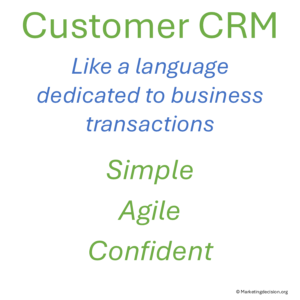
Customer Relationship Management (CRM) systems and CRM software are key to supporting business operations related to customers.
They help Sales, Marketing, and other functions streamline processes, automate tasks, and improve the overall customer experience.
A CRM system deeply transforms organizations, making them more customer-centric. Customers are no longer “owned” by individual salespeople, but by the company as a whole. Performance and success shift from one person to a collective success, enabled by collaboration and the shared data that the CRM tools provide.
Many articles list CRM benefits and risks, but fewer address the journey and investment required. Here are some key sources:

Key CRM features and benefits include:
CRM creates a shared language across the company, improving efficiency around customer needs. When selecting a CRM, consider how it will transform daily interactions with customers and support the customer-centric values important to your business.
This shared language connects closely to building strong customer personae, helping teams align around customer understanding.
When selecting a CRM platform, you need to evaluate multiple selection criteria: features, performance, cost, and efficiency. Useful guides include:
Checklist of key CRM features to evaluate:
Learn from other companies’ experience. Understand their CRM adoption strategy, what worked, and where they struggled. Successful deployment is gradual and requires coordination across all stakeholders.
Market research methods can also help you compare vendors and prioritize what matters most.
Adopting a CRM system requires more than just software installation. It is a long-term journey involving people, culture, and processes. Many sources share tips on CRM, but a few essentials are often overlooked. These can make the difference between a system that works and one that frustrates:

1. Avoid the “management-only” trap.
A CRM should not be treated merely as a reporting tool for executives. That mistake limits its value and discourages adoption. The real priority is to empower Sales, Marketing, Manufacturing, Quality, and other customer-facing teams to simplify their work and delight customers. Once frontline teams are supported, management will naturally benefit from better visibility into sales progress and market penetration.
2. Build a cross-functional CRM team.
Successful implementation requires more than IT expertise. Involve individuals with hands-on knowledge of sales, marketing, and customer operations. Define clear roles and responsibilities, and ensure accountability is shared across functions — with leadership engaged in guiding the process.
3. Set a clear mission and objectives.
CRM adoption is a long-term journey, not a short-term project. Define a mission that keeps the company externally focused and aligned behind customer-facing functions. Objectives must remain relevant to evolving priorities, ensuring the CRM continues to support growth and market presence.
4. Remember that adoption is non-negotiable.
A CRM only delivers value if people actually use it. Customer satisfaction, measured for instance through Net Promoter Score (NPS), depends on consistent adoption. Treat your sales and marketing teams as internal customers: listen to their concerns, address their challenges, and make them advocates for the system. Happy salespeople create happy customers.
Selecting a CRM system is a long-term commitment. Once chosen, focus on future improvements and align the CRM with your company’s strategic goals.
Best practices for success:
For further guidance, you can explore:
Visit also the Marketing Mix Decision chapter for more tools to evaluate and compare CRM solutions.
Adopting a CRM system is not a one-time project but a strategic investment. It begins with system selection and continues through adoption, years of refinement, and periodic evaluations.
Over time:
Plan enhancements, celebrate adoption successes, and keep aligning CRM usage with evolving business needs.
CRM adoption connects closely to your overall Customer Marketing Mix strategy — ensuring customer-centric tools reinforce business growth.
© marketingdecision.org
Selecting a CRM system is a long-term decision and commitment. Once a CRM is chosen, the focus shifts to identifying future improvements and ensuring the system continues to meet evolving business needs. The selection and development of a CRM should always align with your company’s strategic goals and processes.
It’s important to apply market research techniques not only to your customers but also internally—gathering feedback from sales teams, both direct and indirect, as well as back-office staff. Project selection and prioritization can benefit from decision-making tools such as scorecards, which help compare different solutions and maximize the return on investment.
A practical first step is to ask, “What does success look like?” for your CRM project. This grounds the discussion in real needs and objectives, which may vary across individuals and teams. Using the frame in/out framework is an effective way to gather expectations and suggestions from all stakeholders, ensuring broad participation and alignment from the outset. This approach helps prevent scope changes or shifting objectives later in the project.
Visit also the Marketing Mix Decision chapter for more tools to evaluate and compare CRM solutions.
The following section may include tools, some free, some with a fee to support this site development. If you consider a tool should be presented in this section and is missing, please let us know at: contact@marketingdecision.org
© 2025 MARKETING DECISION SOLUTIONS. All Rights Reserved.